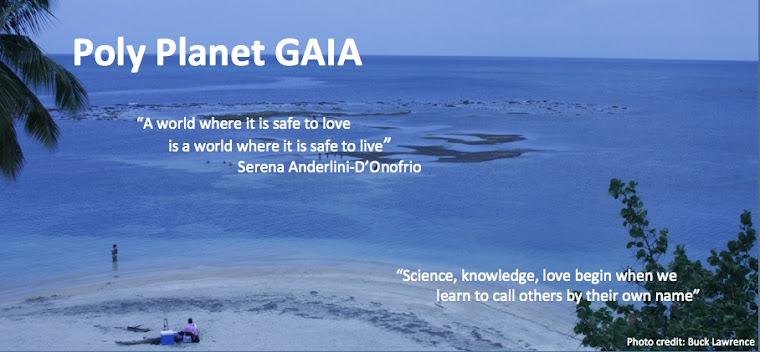Dear Earthlings:
The
EcoSex course at U Conn is in process. It's a great experience. We
are reading amazing books. Thinking out of the box and across
disciplines. Students are sending their responses in, with discussion
questions. In class, we connect the dots: a
holograph of what we've read together, the "required readings."
Multiple perspectives and good synergy. Here, we offer a glimpse.
Stefanie Iris Weiss's EcoSex: Go Green Between the Sheets, was one of two introductory books. We got five responses: from John, Alex, Adam, Rhiann, Alissa, and Michael.
Here's Alissa's take:
Eco-sexuality has a viable
argument for why people should change their habits not only to help the
environment we live in, but to protect themselves as well. I think the fatal
flaw to eco-sexuality is that considering it is a newer topic, not enough
people are well versed in the subject matter. After reading Eco-Sex I feel as if I am more aware of
the subject, but prior to reading the book I had no idea about all the waste
and hazards to things that seemed as simple as perfume. The book is not only
useful in the respect that it can educate others, but it elaborates and gives
sources and alternatives. The problem I always saw with buying organic
products, before enough knowing about all the false advertising that surrounds
green products, is that they are much more expensive. Organic products always
seemed to be more expensive, but the author points out that there are cheaper
“do it yourself” methods that not only work, but are fairly easy to make.
Eco-sexuality has a huge shock
factor, while reading I wanted to get up and check all the products I own for
certain chemicals and even contemplated the vegan lifestyle. Admittedly I was
scared while reading the book, thinking about how all the products I have used
could be causing me harm on the inside or could lead to things as extreme as
cancer. Eco-sexuality is not just about saving the environment it is about
making a change to satisfy yourself and your future. The concept of
eco-sexuality is particularly appealing because it includes more than just
buying products that are eco-friendly but the term “eco” applies to how the
product came to be. What type of materials a product was wrapped in, or how are
the conditions for the workers who made the product? Eco-sexuality encompasses
a wide range of factors that affect how the product came to be.
Eco-sexuality is a striking
concept because in the book it speaks about improving your sex life by eating
correctly or doing natural things to relax, but in the end the book is speaking
about activities and products that will create a healthier and happier person.
The tips given that follow the guidelines of eco-sexuality are the keys to a
happier, more secure you. The book takes the focus off buying things because it
is the easy choice or not exercising because you do not feel like it.
Eco-sexuality focuses on the positive effects that living an eco-sexual life
will give you. The author makes the reader more aware of ways to boost their
morale while doing something that is healthy and environment friendly.
 The author presents a new
perspective of that opposing the media and the greenwashing or brainwashing
they lead members of society to believe absurd ideas. I like how the author
still allows the reader to hold their own opinion, but allow them to view the
situation from an alternate perspective. The author shows how the media and
pharmaceutical companies make people insecure about problems that may be easily
fixable. Stephanie Iris Weiss allows her
readers the freedom to be themselves while reading. She does not force any
ideas upon her readers, but gives them sources to back up her opinions and the
ideals of eco-sexuality.
The author presents a new
perspective of that opposing the media and the greenwashing or brainwashing
they lead members of society to believe absurd ideas. I like how the author
still allows the reader to hold their own opinion, but allow them to view the
situation from an alternate perspective. The author shows how the media and
pharmaceutical companies make people insecure about problems that may be easily
fixable. Stephanie Iris Weiss allows her
readers the freedom to be themselves while reading. She does not force any
ideas upon her readers, but gives them sources to back up her opinions and the
ideals of eco-sexuality.
Why do you think that more people have not adapted to an
eco-sexual lifestyle?
What are the disadvantages you see or that could potentially
create a problem in living an eco-sexual lifestyle?
Does society’s view or conformity make an eco-sexual
lifestyle more difficult to lead?
Alissa Maus
Published with permission
WGSS 3998 - Ecosexuality and the Ecology of Love
Prof. Serena Anderlini-D'Onofrio
U Conn, Storrs, Spring 2013
Dear Earthlings:
Let "nature" be your teacher in the arts of love. Education is the heart of democracy, education to love. Come back for more wonders: Students Responses to appear every Tuesday. Book Reports scheduled every other Thursday. Check out our summer offerings: Ecosexuality in Portland, OR, July 17-21. Info and Registration here!
Namaste,
Serena Anderlini-D'Onofrio, PhD
Gilf Gaia Extraordinaire
University of Puerto Rico, Mayaguez
Follow us in the social media
Poly Planet GAIA Blog:
http://polyplanet.blogspot.
http://polyplanet.blogspot.
Website: www.serenagaia.com
Be Appraised of Ecosex Community Project PostaHouse
Become a Fan: www.facebook.com/GaiaBlessings
Author's Page/Lists all books:
YouTube Uploaded Videos: http://www.youtube.com/












